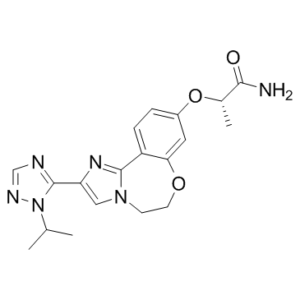GDC-0326
This product is for research use only, not for human use. We do not sell to patients.

For small sizes, please check our retail website as below: www.invivochem.com
| Size | Price | Stock |
|---|---|---|
| 250mg | $1450 | Check With Us |
| 500mg | $2080 | Check With Us |
| 1g | $3120 | Check With Us |
Cat #: V4526 CAS #: 1282514-88-8 Purity ≥ 98%
Description: GDC-0326 is a novel, potent and selective PI3Kα (α-Isoform of Phosphoinositide 3-Kinase) inhibitor with a Ki of 0.2 nM.
Top Publications Citing Invivochem Products
Publications Citing InvivoChem Products
Product Promise

- Physicochemical and Storage Information
- Protocol
- Related Biological Data
- Stock Solution Preparation
- Quality Control Documentation
| Molecular Weight (MW) | 382.42 |
|---|---|
| Molecular Formula | C19H22N6O3 |
| CAS No. | 1282514-88-8 |
| Storage | -20℃ for 3 years in powder formr |
| -80℃ for 2 years in solvent | |
| SMILES Code | C[C@H](OC1=CC=C2C3=NC(C4=NC=NN4C(C)C)=CN3CCOC2=C1)C(N)=O |
| Synonyms | GDC-0326; GDC 0326; GDC0326 |
| Protocol | In Vitro | GDC-0326 is highly selective over other kinases. In a panel of 235 kinases, only one is inhibited by >50% by GDC-0326 when tested at 1 µM. GDC-0326 is not an inhibitor of cytochrome P450 enzymes tested (IC50>10 µM against 3A4, 2C9 1A2, 2C19, 2D6), is highly permeable in MDCK cells and has thermodynamic solubility of 82 µg/mL at pH 7.4. |
|---|---|---|
| In Vivo | GDC-0326 is highly stable in human and rat liver microsomes, and there is a good correlation with in vivo rat clearance. It is found to have consistently low clearance and high oral bioavailability across species tested, enabling significant sustained free drug levels. Daily administration of GDC-0326 orally at 0.78, 1.56, 3.25, 6.25, or 12.5 mg/kg results in dose-dependent increase in TGI (73%, 79%, 83%, 101%, and 110%, respectively) and tumor regressions (6 PRs out of 10 animal at 6.25 and 12.5 mg/kg) when compared to vehicle treated mice. Daily administration of GDC-0326 orally at 0.78, 1.56, 3.25, 6.25, or 12.5 mg/kg also results in dose-dependent increase in TGI (73%, 97%, 97%, 122%, and 121%, respectively) in the KPL-4 xenograft model. Notably, maximum efficacy of GDC-0326 is observed at 6.25 mg/kg in the KPL-4 model based on TGI and tumor regressions (9 PRs and 1 CR out of 10 animal treated) when compared to vehicle treated mice. Doses of GDC-0326 up to 12.5 mg/kg are well tolerated based on less than 10% body weight loss (data not shown). |
These protocols are for reference only. InvivoChem does not
independently validate these methods.
| Solvent volume to be added | Mass (the weight of a compound) | |||
|---|---|---|---|---|
| Mother liquor concentration | 1mg | 5mg | 10mg | 20mg |
| 1mM | 2.6149 mL | 13.0746 mL | 26.1493 mL | 52.2985 mL |
| 5mM | 0.5230 mL | 2.6149 mL | 5.2299 mL | 10.4597 mL |
| 10mM | 0.2615 mL | 1.3075 mL | 2.6149 mL | 5.2299 mL |
| 20mM | 0.1307 mL | 0.6537 mL | 1.3075 mL | 2.6149 mL |
The molarity calculator equation
Mass(g) = Concentration(mol/L) × Volume(L) × Molecular Weight(g/mol)
Mass
=
Concentration
×
Volume
×
Molecular Weight*
The dilution calculator equation
Concentration(start)
×
Volume(start)
=
Concentration(final)
×
Volume(final)
This equation is commonly abbreviated as: C1 V1 = C2 V2
Concentration(start)
C1
×
Volume(start)
V1
=
Concentration(final)
C2
×
Volume(final)
V2
Step One: Enter information below
Dosage mg/kg
Average weight of animals g
Dosing volume per animal µL
Number of animals
Step Two: Enter the in vivo formulation
%DMSO
+
%
+
%Tween 80
+
%ddH2O
Calculation Results:
Working concentration:
mg/ml;
Method for preparing DMSO master liquid:
mg
drug pre-dissolved in
µL
DMSO(Master liquid concentration
mg/mL)
,Please contact us first if the concentration exceeds the DMSO solubility of the batch of drug.
Method for preparing in vivo formulation:
Take
µL
DMSO master liquid, next add
µL
PEG300, mix and clarify, next add
µL
Tween 80,mix and clarify, next add
µL
ddH2O,mix and clarify.
Note:
- (1) Please be sure that the solution is clear before the addition of next solvent. Dissolution methods like vortex, ultrasound or warming and heat may be used to aid dissolving.
- (2) Be sure to add the solvent(s) in order.




































